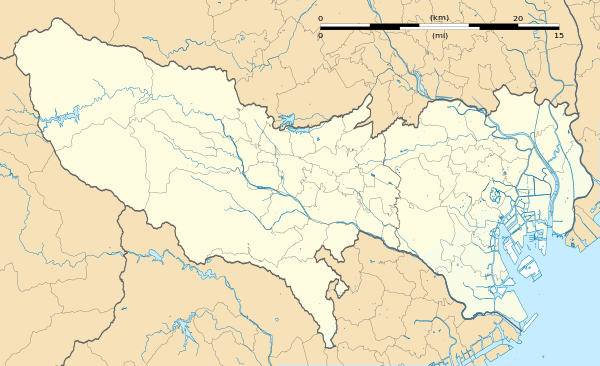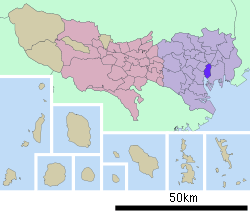Nihombashi Station
Nihombashi Station (日本橋駅, Nihonbashi-eki) is a subway station in the Nihonbashi district of Tokyo, Japan, jointly operated by Tokyo Metropolitan Bureau of Transportation (Toei) and Tokyo Metro.
G11 T10 A13 Nihombashi Station 日本橋駅 | |||||||||||||||||||||||||||||||
|---|---|---|---|---|---|---|---|---|---|---|---|---|---|---|---|---|---|---|---|---|---|---|---|---|---|---|---|---|---|---|---|
 Exit B7 in August 2019 | |||||||||||||||||||||||||||||||
| Location | 1 Nihonbashi, Chūō-ku, Tokyo Japan | ||||||||||||||||||||||||||||||
| Operated by | |||||||||||||||||||||||||||||||
| Line(s) |
| ||||||||||||||||||||||||||||||
| Platforms | 1 island platform, 1 side platform (Ginza Line) 2 side platforms (Asakusa Line) 1 island platform (Tozai Line) | ||||||||||||||||||||||||||||||
| Tracks | 6 | ||||||||||||||||||||||||||||||
| Construction | |||||||||||||||||||||||||||||||
| Structure type | Underground | ||||||||||||||||||||||||||||||
| Other information | |||||||||||||||||||||||||||||||
| Station code |
| ||||||||||||||||||||||||||||||
| History | |||||||||||||||||||||||||||||||
| Opened | December 24, 1932 | ||||||||||||||||||||||||||||||
| Rebuilt | 1963, 1967, 1984 | ||||||||||||||||||||||||||||||
| Previous names | Edobashi (Asakusa Line, 1963–1989) | ||||||||||||||||||||||||||||||
| Services | |||||||||||||||||||||||||||||||
| |||||||||||||||||||||||||||||||
| Location | |||||||||||||||||||||||||||||||
 Nihombashi Station Location within Tokyo | |||||||||||||||||||||||||||||||
Lines
Nihombashi Station is served by the following lines.
- A Toei Asakusa Line (second basement)
- G Tokyo Metro Ginza Line (second basement)
- T Tokyo Metro Tōzai Line (third basement)
Station layout
The Ginza Line station originally opened as an island platform serving two tracks, but overcrowding prompted the construction of a side platform serving Shibuya-bound trains in 1984. The island platform currently serves only Asakusa-bound trains, and the Shibuya side of the platform is fenced off.
The Tōzai Line station consists of an island platform serving two tracks, while the Asakusa Line station consists of two side platforms with two tracks between them. At the Asakusa line station, passengers must choose their direction before passing through the ticket gates.
Tokyo Metro platforms
| 1 | G Tokyo Metro Ginza Line | for Akasaka-mitsuke and Shibuya |
| 2 | G Tokyo Metro Ginza Line | for Ueno and Asakusa |
| 3 | T Tokyo Metro Tōzai Line | for Urayasu and Nishi-funabashi JB Sōbu Line (Local) for Tsudanuma TR Tōyō Rapid Railway Line for Tōyō-Katsutadai |
| 4 | T Tokyo Metro Tōzai Line | for Ōtemachi, Takadanobaba and Nakano JB Chūō Line (Local) for Mitaka |
 Ginza Line platforms, 2006
Ginza Line platforms, 2006 Tozai Line platforms in March 2013
Tozai Line platforms in March 2013 Tozai Line platforms, February 2020
Tozai Line platforms, February 2020
Toei Subway platforms
| 1 | A Toei Asakusa Line | for Sengakuji and Nishi-magome KK Keikyū Main Line for Shinagawa, Haneda Airport (International Terminal and Domestic Termimal), Yokohama and Misakiguchi |
| 2 | A Toei Asakusa Line | for Oshiage KS Keisei Main Line for Aoto, Keisei Narita and Narita Airport (Terminal 2·3 and Terminal 1) KS Narita Sky Access Line for Narita Airport HS Hokusō Line for Inba-Nihon-Idai SR Shibayama Railway Line for Shibayama-Chiyoda |
 Asakusa Line platforms, 2006
Asakusa Line platforms, 2006
History
The Tokyo Underground Railway (which built the Asakusa-Shimbashi section of the Ginza Line) opened a station here on December 24, 1932, when they extended the line south to Kyōbashi. On September 1, 1941, they merged with the Tokyo Rapid Railway to form the Teito Rapid Transit Authority (TRTA).
The next development was the opening of Edobashi Station on February 28, 1963, when Toei Line 1 was extended to Higashi-Ginza. Transfer was allowed between the two lines here, but the complex only became a true interchange when the Tōzai Line station opened on September 14, 1967.[1]
Toei Line 1 only received its name – the Asakusa Line – on July 1, 1978, and Edobashi station was renamed on March 19, 1989 to avoid confusion with Edogawabashi Station on the Yūrakuchō Line, which opened in 1974.
See also
References
| Wikimedia Commons has media related to Nihombashi Station. |
- Schwandl, Robert. "Tokyo". UrbanRail.Net. Retrieved 30 May 2013.
